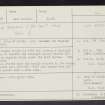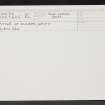Spott, Battle Of Dunbar
Battle Site (13th Century)
Site Name Spott, Battle Of Dunbar
Classification Battle Site (13th Century)
Canmore ID 57629
Site Number NT67NE 28
NGR NT 6750 7604
NGR Description Centred on NT 6750 7604
Datum OSGB36 - NGR
Permalink http://canmore.org.uk/site/57629
- Council East Lothian
- Parish Spott (East Lothian)
- Former Region Lothian
- Former District East Lothian
- Former County East Lothian
NT67NE 28 6750 7604.
(NT 6750 7604) Site of Battle (NR) Between the English and Scots AD 1296.
OS 6" map (1959)
The Battle of Dunbar fought in 1296 was between a Scottish force, marching to relieve the besieged Dunbar Castle (NT67NE 8) and an English force under the Earl Warren. The Scots were routed. The Ordnance Survey Name Book (ONB) states that the battle started in the valley between Broomhouse Mill (NT 6827 7638) and Oswald Dean (NT 6895 7652) and spread over a wide area.
NSA 1845 (J Jaffray); Name Book 1853
Battle of Dunbar - 27th April 1296.
L H Dawson, undated
No further information.
Visited by OS (RD) 22 March 1966
Online Gallery (1306 - 1329)
The year 2014 sees the 700th anniversary of the Battle of Bannockburn, in which the army of Robert I of Scotland defeated that of Edward II of England. The battle marked a major turning point in the long, drawn-out struggle of the Wars of Independence.
The Wars have had a lasting influence upon all the nations of the United Kingdom and upon the national story. Each age has seen fit to commemorate the events in its own way: through the perpetuation of the genuine historical associations of buildings and places and also through the endowment of others with improbable or fanciful traditions. Where past generations allowed its historic buildings to decay and disappear, later generations began to value and actively preserve these for their associations. Where an event lacked a tangible reminder, as at Kinghorn where Alexander III was killed in a riding accident, a commemorative monument would be erected to act as a focus. The Wars of Independence predate the fashion for accurate portraiture: the weathered, generic military effigy of Sir James Douglas is one of the few to survive in Scotland. Later centuries saw a need and supplied it by a crowd of images of its historic heroes, William Wallace and Robert the Bruce, each depicted according to contemporary taste and imagination. The opening of the new heritage centre at Bannockburn takes this into a new dimension, through the use of three-dimensional, digital technology.
RCAHMS Collections hold many images of these buildings and locations from battlefields, castles and churches, to the many commemorative monuments erected in later years. This gallery highlights a selection of these, including antiquarian sketches, photographic and drawn surveys, and architectural designs.










